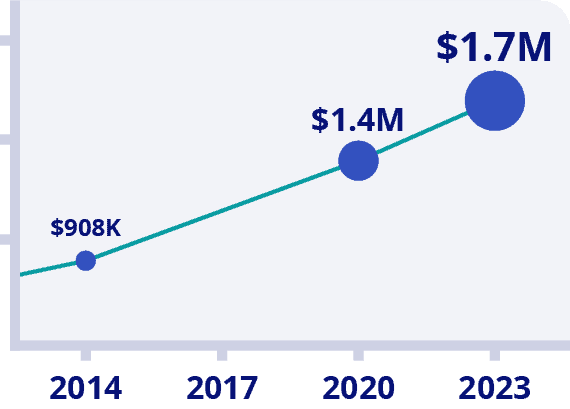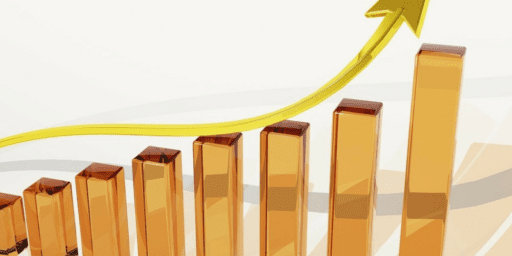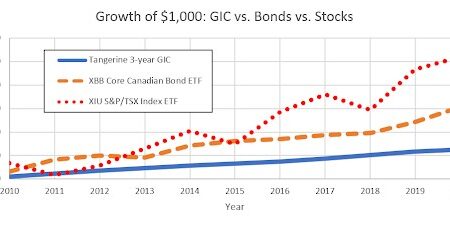OAS in Canada: Clawbacks, Eligibility and Payment Dates
Old Age Security – better known as OAS – is one of the least understood aspects of Canadian retirement planning that I’ve come across.
In order to full wrap your head around OAS and how you can get the most out of it for your particular situation, this deep dive is going to cover: (use the table of contents below to jump to the section that pertains to you)
- OAS Eligibility (Who gets full or partial OAS)
- What is the OAS Clawback? (How Do I Keep My Whole OAS Cheque?)
- How Much OAS Will I Get?
- When are OAS Payment Dates for 2024?
- Should I Defer Taking My OAS?
- FAQ about OAS in Canada
Are You Saving Enough for Retirement?

Canadians Believe They Need a $1.7 Million Nest Egg to Retire
Is Your Retirement On Track?
Become your own financial planner with the first ever online retirement course created exclusively for Canadians.
Get $50 Discount With Promo Code MDJ50
*100% Money Back Guarantee
*Data Source: BMO Retirement Survey
What is OAS and Is OAS a Pension?
Old Age Security (OAS) is a payment that the government sends to Canadian residents and/or citizens each month. You must be over the age of 65 to receive an OAS payment, but you can also choose to defer taking your OAS (which we’ll talk more about later).
The maximum non-deferred monthly OAS payment for those aged 65 to 75 in 2024 is $713.43.
The maximum monthly non-deferred OAS payment for those aged 75 and older in 2024 is $784.67.
The government calls OAS payments an “Old Age Security Pension”. I really wish they would stop doing that. One of the fundamental issues with Canada’s social safety net for retirees is that we have two completely separate programs:
- Old Age Security (OAS)
- Canadian Pension Plan (CPP)
If you think about a “pension” as something that you have paid into – and which doesn’t depend on Canada’s annual tax revenues – then it makes sense to call CPP a pension, and just refer to OAS as… OAS.
The key difference between OAS and CPP is that while you were working in Canada, you got a little bit taken off of your cheque every month to fund your CPP account. We’ll discuss the CPP more in another article, but for now, just understand, the CPP is your money that has been invested and will be coming back to you. The amount you get will depend on how much you paid into the CPP.
The OAS is NOT funded with money that you paid while you were working. It is paid for out of general tax revenue that the federal government receives each year.
If you want to thoroughly understand how the OAS fits into your overall financial plan in retirement I recommend checking out the one-of-a-kind retirement course that I created called 4 Steps to a Worry-Free Retirement. For a free preview of what’s in the course click here.
OAS Eligibility (Who Gets OAS in Canada)
The vast majority of Canadians will automatically be OAS eligible as they live in Canada and turn 65. However, you can also be eligible for OAS payments even if you live outside of Canada.
It’s important to note that unlike CPP, you DO NOT have to have worked in Canada in order to qualify for OAS.
You can receive some amount of OAS if you meet the following eligibility criteria – and are currently living in Canada.
- You are 65-years-old or older
- You are a Canadian citizen or legal resident at the time your approve your OAS pension application is looked at
- You have resided in Canada for 10 years or more since the age of 18
You can receive some amount of OAS if you meet the following eligibility criteria – and are NOT currently living in Canada.
- You are 65-years-old or older
- You are a Canadian citizen or legal resident at the time your OAS pension application is approved
- You had resided in Canada for at least 20 years since the age of 18
There are also some unique rules in regards to OAS eligibility years if you spent time working outside of Canada, but for Canadian employers such as the armed forces or large banks. See Canada.ca for more details.
Finally, Canada has some unique social security reciprocal agreements with more than 50 countries around the world. What these agreements basically mean is that your OAS and CPP eligibility years might get a boost if you paid into another country’s social security plans. See Canada.ca for more details.
In order to collect the maximum OAS pension payment in Canada you need to have lived in Canada for 40 years after the age of 18. If you have lived in Canada for less than 40 years, but still meet the eligibility criteria above, then you will get a proportional amount of the maximum OAS payment.
For example, if you were born in Canada, lived there until you were 21, then went abroad to pursue a career for 27 years (returning to live in Canada at 48), then you would have lived in Canada a total of 20 years between the ages of 18 and 65. Consequently, you would be eligible to receive half (20/40) of the maximum OAS payment.
Applying for Your Old Age Security
Many Canadians will not need to fill out an application for OAS. The government will simply send them a letter that says they will begin to receive the Old Age Security (OAS) pension – along with your personal details.
However – you will need to apply if you instead get a letter from the government that states you need to fill out an application. (This can happen for a few different reasons, but usually is in regards to people who have immigrated to Canada or lived outside the country for an extended period of time.)
Or – if the information in the government’s letter is incorrect, you will also have to go through the OAS application process.
Or – if you want to defer your OAS payment to begin at some point other than at age 65.
You can apply for OAS when you are one month past your 64th birthday. There is an online application and a paper-mail based application option. Full OAS application details can be found here at Canada.ca.
The OAS Clawback: Income, Threshold, Dividends, and Pension Splitting
The OAS clawback (which the government calls the OAS pension recovery tax) is an important aspect of financial planning for 65+-year-olds who are still working, or who are fortunate to have a substantial amount of income from investments available to them in retirement.
The basic idea is that the government has decided that folks who earn more than a certain amount of money probably don’t need more help from the government. That number currently sits at $81,761 (until June 2024, when it will go up to $86,912 ), and will go up with inflation from there..
The way the OAS clawback is calculated is based on the net income you reported on your tax return for the previous calendar year. That said, if you know that your income for the current calendar year is going to be substantially less than the prior year, you can use a T1213(OAS) form to lessen your clawback for the current year.
After you earn more than that amount in income, the government is going to start taking away (or “clawing back”) more and more of your OAS money until you hit the $134,626 level, and at that point you will no longer receive any OAS.
Ultimately, the OAS clawback is an additional 15% tax on every dollar that you earn above the $81,761 threshold.
For example, if you earned $94,761 during the “OAS year” from July 2023 to June 2024, the CRA would calculate that you earned $13,000 above the OAS clawback threshold. When the 15% pension recovery tax is applied to that amount we get $1,950.
Now, instead of applying this tax calculation on your normal tax return, the government will instead automatically adjust your OAS for the following “OAS year” to reflect the amount getting clawed back. In our above example, $162.50 would be subtracted each month from your OAS payments in order to “pay the pension recovery tax” for the prior year.
If for some reason our July 2024 – June 2025 income was going to be lower than our past year’s income, we could use the T1213(OAS) form to request a reduction or elimination of the OAS recovery tax.
What Counts as Income for the OAS Clawback?
Understanding how different “pots of money” either count, or don’t count towards your OAS taxable income threshold can be a bit of a process. Most people who have this much annual income in retirement will simply work with an accountant to optimise their after-tax income. If you’re doing some preliminary planning on your own, here are a few things to keep in mind:
1) Money that is spent during the year that has already had tax paid on it, such as money that was put in a chequing or savings account, is not taxable income for that year.
2) Any withdrawals from your TFSA do not count towards your taxable income.
3) Any withdrawals from your RRSP are taxable income.
4) Your OAS and CPP are considered taxable income.
5) Any interest that you earn from products such as GICs or high-interest savings accounts – that are outside registered accounts such as an RRSP or TFSA – are taxable income.
6) Capital gains on assets that are outside of registered accounts are taxable income (but remember to apply the capital gains 50% tax inclusion rate).
7) Dividend payments from investments that are outside of registered accounts are taxable income – and are a bit confusing to calculate.
In order to figure out how these dividends will affect your OAS threshold, you first have to take the actual amount of dividend income that you received – and then “gross up” that amount, to get the figure that will count towards your taxable income.
The “gross up” means that you multiply the amount of dividend cash that you received by 138% (if the dividends were eligible dividends from a big publicly traded government in Canada) or by 116% (if the dividends were non-eligible dividends from a smaller Canadian Controlled Private Company – CCPC).
8) Perhaps most importantly when it comes to avoiding the OAS clawback – remember that there are some great pension-splitting options available to Canadians once they turn 65. By using pension splitting and listing your non-registered investments under both of your names (held in a joint account) it is usually possible to make sure that your retirement income gets split evenly – thus allowing couples to earn almost $160,000 in Canada before they will incur any OAS clawback taxation.
Quick Note: Unlike your OAS, your CPP cannot be clawed back.
| Type of Money in Your Retirement Paycheque | Is it Taxable Income? |
| Money that has already had tax paid on it, and was sitting in a chequing or savings account | No |
| Private Pension | Yes |
| TFSA Withdrawal | No |
| RRSP or RRIF Withdrawal | Yes |
| OAS & CPP Payments | Yes |
| Interest From Money in GICs or High Interest Savings Accounts Outside of Registered Accounts, Such as an RRSP or TFSA | Yes |
| Capital Gains Earned on Investments Outside of Registered Accounts Such as an RRSP or/and TFSA | Yes, at a 50% inclusion rate |
| Dividend Payments on Investments Outside of Registered Accounts | Yes, see below for details |
Should I Defer Taking My OAS?
The vast majority of financial experts agree that the average Canadian should defer taking their OAS and CPP as long as they can afford to in – in most cases. (“It depends” is a popular saying amongst planners.)
Yet roughly 94% of Canadians choose not to defer their OAS. We’ll discuss CPP in our next episode, but the statistics are similar there.
Since 2012 Canadians have been allowed to defer their OAS payments. The Canadian government is willing to pay you .6% more for each month you decide that you delay taking your OAS payment, plus you’ll benefit from the automatic inflation increase.
It’s important to understand exactly what this means: Each year that you delay your OAS, the Canadian government is going to give you an automatic guaranteed 7.2% + inflation return on your “time delay investment”.
That’s a pretty amazing financial planning tool to use for retirement. It might not be for everyone, but deferring your OAS is an option that many more Canadians should choose. Like most other personal finance decisions, it’s all about trade-offs.
What deferring your OAS comes down to for most people is:
1) If you really need the income, then there isn’t much more consideration needed. Canadian pension guru Fred Vettese has stated that he uses $200,000 in savings as the cut off line. In other words, if you don’t have a minimum of $200,000 in savings/investments when you turn 65 – and you’re done with the working world for one reason or another – then you’re probably best off ignoring the rest of this and just taking your OAS at 65.
2) If you have significant reasons to believe that you will pass away before 80, then you’re better off taking OAS at 65. There are a wide variety of life expectancy calculators out there, but remember that you’re not looking at “birth life expectancy”, but instead the life expectancy for someone who has already made it to 65.
After reading numerous studies, I’d put the average life expectancy for today’s 65-year-old Canadian male at about 85, and the average 65-year-old Canadian female at about age 88. Another way of looking at this, is that there is a 1-in-10 chance that you’ll live to be 99!
The main risk factors for falling on the wrong side of that life expectancy average include smoking, obesity, alcohol consumption, driving habits, and blood pressure. After these behavioural factors, family history would come into play. The more of those boxes that you check off, the greater the occurrence of a debilitating condition before the age of 65, and the more attractive taking OAS at 65 becomes.
For what it’s worth, Vettese recently wrote in the Globe and Mail, “The probability of premature death is small. Between ages 65 and 80, there is only a 13 per cent chance of dying if you are female and 20 per cent if you are male.”
3) How do you personally value the trade-off between life-long guaranteed government income (the ultimate hedge against living to extreme old age) vs leaving behind more of an inheritance if you were to pass away before the age of 80.
There is no right or wrong answer to this tradeoff. Personally, I told my parents, I’d like them to spend their money on themselves, and enjoy the reduced stress of having a significant amount of guaranteed income no matter how long they live – but it’s their money!
By far the most common fear that financial planners hear from Canadians when they ask them to consider delaying OAS goes something along the lines of:
“Well what if I use up all (or a lot of) my savings between the ages of 65 and 70 – all so that I get this increased OAS payment – and then I pass away at 75! Now the government gets to keep all my money and I leave nothing for an inheritance.”
While there is no denying the unpleasant reality that the above scenario could occur – it’s important to realize that it’s fairly unlikely (as our average life expectancy shows). The more relevant risk factor is actually having your savings run out in extreme old age, and then needing to drastically reduce lifestyle considerations, and/or depending on family for financial help. The increased OAS payment is an absolute safeguard against that eventuality.
Withdrawing a substantial amount of your investments before 70 can also mean that you get to keep more of your money due to being in a lower tax bracket when you withdraw RRSP income – and can even help avoid the OAS clawback by spreading your withdrawals over more years. You also get a higher OAS clawback ceiling by delaying your OAS.
Finally, when it comes to inheritance, remember that if you were to pass with assets in an RRSP, that money is likely to get taxed at the highest tax rate, as it will all be deemed income for the year you pass away. Non-registered accounts would also trigger capital gains in a similar manner. If you have other assets (such as a house) that you could bequeath to your loved ones, then perhaps this tilts the trade off in the direction of deferring OAS at least part of the way to 70.
Oh – and the delayed OAS plan actually gets even stronger when we factor in the recent after-75 OAS boost that was recently announced. A delayed OAS, now means that your 36% increase will be applied to a bigger OAS payment in your later years.
Deferring OAS vs CPP
While many of the same arguments for delaying OAS can also apply to a CPP, you get more bang for your buck by delaying your CPP. Consequently, most experts like Mr. Vettese recommend first delaying the CPP if at all possible, and then after that, if you have the private pension or savings to manage it, delaying your OAS would be the next step.
CPP payments go up more for each year you delay. The other relevant consideration for a lot of couples is that it’s possible to “top up” a surviving spouse’s CPP payments in the case one partner passes – and that benefit does not exist for the OAS.
“Take the Money and Invest It” vs Deferring OAS
Whenever an expert (who often has a degree related to actuarial maths) writes in an article or a book that many Canadians would be better off if they delayed their OAS payment until age 65 – they are often ambushed by online commenters who immediately state (with 100% conviction that they know better than the expert) that the author is dead wrong.
Usually the argument goes something along the lines of:
“First of all – you ALWAYS take the government money when you can because there is no guarantee and they could take it all away tomorrow. Don’t be dumb!”
Some commenters will then go on to say:
“Ok, sure you might be further ahead by waiting until 70 – IF you were to just spend your OAS payments right away. But what if you took that OAS money and then invested it instead? Now you get to keep your money within your estate AND you will be further ahead once you turn 70.”
This argument ignores a few things:
1) First and foremost, the chances of the OAS somehow going away or “running out” are so small as to be almost irrelevant. I’ve discussed this with many different financial advisors and Canadian authors – not one has expressed any worries about OAS going away or changing in the next 20 years (and I think it’s safe even beyond that).
Politically angering the 55+ year olds in Canada (and this would infuriate them) is not a serious policy platform for any party in Canada. The Harper government tried to slowly phase in a small increase to the OAS age, and it was generally credited as being a main reason the Trudeau government was able to win over many pensioners back in 2015. I mean, the current government just raised the OAS for folks who are 75 and above.
2) There is a value to be placed on simplicity. To get the full optimization of handling your own investments into your mid-to-late 80s you have to assume that either you’ll experience minimal cognitive decline and/or be able to 100% trust a very competent person to manage your investments for you.
Both of those scenarios carry substantial risk. Simply delaying OAS results in a guaranteed increased amount of money being auto-deposited in your bank account each month until your final day. That’s a pretty significant tradeoff.
3) Let’s talk investment return scenarios. It’s not nearly as simple as it looks at first glance. A lot of people will say, “Hey, the stock market has returned 10% per year on average, that’s a lot more than 7.2%, plus I’m collecting money for 5 extra years, so I’m way ahead of the game to invest my own money + my estate is further ahead at any age.”
Here are the issues with that:
i) Stocks don’t go up in a linear 10% line. In the short term, it can take stocks 5+ years to get back to previous highs.
ii) The 7.2% per year that you get with increased OAS payments is real return – because you will also get an inflation adjustment each year. That 10% stock returns figure is a nominal return (it does not take inflation into consideration).
What you need to figure out is by how much your investments would need to outperform the guaranteed return – after inflation and after tax considerations and after paying investment fees (your OAS return has no MER or advisory fees attached). Most financial experts I’ve read have an expected future risk-premium for stocks of about 3.5-5%. That means stocks should only be about 3.5%-5% higher than general inflation over the long term.
iii) You will need substantial assets, discipline, and investing acumen in order to pass up on taking the OAS, use your own savings to fund your retirement spending so that you can save + invest the OAS payment each month, not spend any of the OAS money even if asset values crash, and then manage to invest your money without paying much fees or taxes, and probably have to beat the market average – all in order to come out ahead.
All that to say that while it’s certainly possible to take your OAS at 65 and invest it in order to push the “break even age” back to 85+, it’s very unlikely that you will get optimal outcomes given average life expectancies and our inherent flaws as rational investors.
Many seniors simply won’t be able to afford to defer their OAS, and in those situations it’s totally ok to take OAS at 65. For folks that have substantial savings or have alternate pension plans to rely on during the ages of 60-70, deferring their OAS can be a very attractive option depending on the tradeoffs described above.
Are You Saving Enough for Retirement?

Canadians Believe They Need a $1.7 Million Nest Egg to Retire
Is Your Retirement On Track?
Become your own financial planner with the first ever online retirement course created exclusively for Canadians.
Get $50 Discount With Promo Code MDJ50
*100% Money Back Guarantee
*Data Source: BMO Retirement Survey
FAQ about OAS in Canada
OAS Payment Dates In 2024
The OAS Payment dates for 2024 are:
- January 29, 2024
- February 27, 2024
- March 26, 2024
- April 26, 2024
- May 29, 2024
- June 26, 2024
- July 29, 2024
- August 28, 2024
- September 25, 2024
- October 29, 2024
- November 27, 2024
- December 20, 2024
As a general rule, the federal government usually pays out the GIS, OAS, and CPP payments all on the same day each month (but not GST payments). It’s often the 3rd-last business day of the month.
Old Age Security (OAS) in Canada – Final Thoughts
After reading through my comprehensive Canadian Old Age Security (OAS) Guide, it should be clear that OAS is a vital component of Canada’s retirement income landscape. It provides a base for financial stability in retirement, but understanding its nuances is key for effective planning.
From eligibility criteria and application processes to strategies for optimizing benefits, the OAS program encompasses various aspects that you should take into consideration when creating your retirement plan.
If you want to see how the OAS piece fits into your complete retirement puzzle, then it’s definitely worth checking out the retirement course that hundreds of Canadians have now taken.
Are You Saving Enough for Retirement?

Canadians Believe They Need a $1.7 Million Nest Egg to Retire
Is Your Retirement On Track?
Become your own financial planner with the first ever online retirement course created exclusively for Canadians.
Get $50 Discount With Promo Code MDJ50
*100% Money Back Guarantee
*Data Source: BMO Retirement Survey











But….starting April 2023 the age to start collecting OAS starts to gradually go up to 67.
By 2029 it will be fully implemented.
No, that was the case Richard (when the Harper government enacted legislation) but the Trudeau government cancelled that proposed change.
Deferring oas increases the maximum income at which full clawback occurs, something to keep in mind.
If you delay taking OAS from 65 to 70 years of age, when is the breakeven point? Or simply put, at what age will you recoup ALL the money that you did no draw from 65-70?.
The breakeven age will change month by month right Gino? In other words, break even at 65 vs 66 vs 68 will all be different. The rule of thumb I’ve read used by most experts is that the breakeven is about 14 years after you take it. So Breakeven for 66 (vs 65) would be 80, if you took it at 70, it’d be 84. That doesn’t take into consideration if you were to take OAS and put the money in an investment (generally referred to as the “time value” of capital).
Does Service Canada provide an update letter when they calculate the new benefit amount in July each year?